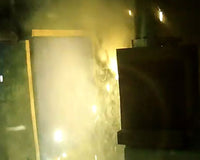Working on live electrical equipment comes with a substantial risk of electric shock and arc flash. Whenever exposed to energized equipment, workers must have a clear understanding of what the potential hazards are and how to work safely. Preventing unsafe conditions is essential, as the consequences of an electrical shock or an arc flash can be devastating.
(If you were to take a look at what some of the best trainers out there are providing Arc Flash Training then you would quickly realise it should be called Electrical Safety Training. For the purposes of today’s article and because that’s what everybody calls it anyway, we are going to refer to it as Arc Flash Training).
What is arc flash training?
Protecting your employees from hazards such as these warrants several interwoven and necessary training components. Two entities – Occupational Safety and Health Administration (OSHA) and the National Fire Protection Association (NFPA) – address specific electrical safety and arc flash training requirements. Together, they help to ensure the protection of those individuals working with electricity through training, risk identification, safe work practices, and applicable PPE requirements.
What are the key topics for Arc Flash Training?
A typical course should follow this flow of information:
- Introduction to the hazards (Arc Flash and shock), how they can hurt you, and what you might be doing when they hurt you
- Understanding the relevant codes and standards and how they apply to you
- Learning how to do an Arc Flash Risk Assessment
- How to decide on mitigation techniques with proper execution
Who needs Arc Flash Training?
Arc Flash Training does not need to be for everyone... but there are likely far more people who could benefit from the training than those of you who have it.
Anyone who is working on or near energized electrical equipment should be aware of the dangers so the simple answer is to say that anyone who works with electrical equipment, or works in an area where an arc flash is possible, should go through arc flash and electric safety training.
OSHA identifies a number of specific job titles that are typically associated with higher levels of risk for arc flash exposure. These include (but not limited to):
- Riggers
- Blue Collar Supervisors
- Welders
- Electrical Engineers
- Mechanics and Repairmen
- Electrical Assemblers
- Material Handling Equipment Operators
- Electrical Technicians
- Industrial Machine Operators
- Electricians
- Stationary Engineers

I usually recommend different levels of training for different job types. The person who works on the floor loading crates needs an awareness training because they are working in the vicinity of energized 480 or 600 volts.
In another case, maybe a 30-year veteran electrician who worked there since the place opened, the worker would need a longer more detailed arc flash training that maybe includes a section on high-voltage and lasts 2 to 3 days.
Long story short... just about everyone needs some form of Arc Flash Training.
How often is Arc Flash Training required?
Most employers within the industry will know that their staff need to undergo arc flash and electrical safety training and have ensured that they have received this, as per the OSHA and NFPA 70E requirements. However, many are unaware that those same employees will need to be re-trained every three years.
There are some circumstances where retraining is necessary, even if it hasn’t been three years since the last time that training occurred. A worker shall receive additional training (or re-training) if any of the following conditions exists: the supervision or annual inspections indicate that the employee is not complying with the safety-related work practices; new technology, new types of equipment, or changes in procedures necessitate the use of safety-related work practices that are different from those that the worker would normally use; the staff member must employ safety-related work practices that are not normally used during their regular job duties.

If the actions of any workers indicates that they’re not clear on arc flash and electrical safety, of if their duties have changed, and now they work with electrical equipment that they did not work with previously, then they will need re-training. Similarly, if electrical equipment has changed, or procedures for handling that equipment have changed, then the affected employees will need re-training.
Clearly, the integrity of an employer’s arc flash and electrical safety training program is key. This training requires instructors with in-depth subject matter knowledge. By using a trusted expert to provide thorough and detailed training it will help workers to develop their skills, awareness, and core competencies to comply with the necessary requirements.
Who provides Arc Flash Training?
Arc Flash Training can be provided by anyone who has the skills and knowledge and technical know-how to do so.
Many companies opt to train in house with their safety and training departments taking the lead while other companies opt for a 3rd party vendor to handle such an important topic.
SKANWEAR® Free Arc Flash Training Support
Aside from Arc Flash Clothing and PPE we have been providing training workshops, documents, programmes, webinars all in support of our mission #savinglives
Looking for support in rolling out training to your team of engineers?
Book a free session with one of our Arc Specialists so we understand your requirements and how best to support your needs.





